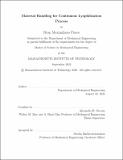Material Handling for Continuous Lyophilization Process
Author(s)
Flores, Ryan Maximiliano
DownloadThesis PDF (182.9Mb)
Advisor
Slocum, Alexander H.
Terms of use
Metadata
Show full item recordAbstract
This paper details solutions to two main challenges with a lyophilization machine: load-lock door design for isolating process chambers from the environment and other process chambers operating at different conditions and vacuum seals for complex geometries that are robust to significant temperature variation.
The load-lock door design solution detailed in this paper is the wedge door. Using a linear actuation motion and large sealing surface angle with respect to the horizontal, the wedge door requires less space compared to the previous rotary designs, four-bar linkage and simple pivot doors. The wedge door has a length normalized leak rate of [︀formula]︀, and lifetime of 41,992 cycles before service is required which is 9.2 months of operation of the lyophilization machine.
In order to seal the complex geometry of the interface between the linear motion system and the load-lock and drying chambers, an injectable vacuum seal was designed. The injectable seal uses Self-leveling Green sealant from Av-DEC injected into a rectangular groove with 2 mm depth and 9.5 mm width and sandblasted sealing surfaces. To fully fill the groove around the linear motion system module, a maximum injection pressure of 45 PSI is required. The injectable seal has a length normalized leak rate of [︀formula]︀.The injectable seal is robust to temperature variation of 10 °C to 25 °C, due to the increased adhesion of sealant to the sealing surfaces due to the increase roughness of the sandblasted surfaces.
Date issued
2022-09Department
Massachusetts Institute of Technology. Department of Mechanical EngineeringPublisher
Massachusetts Institute of Technology